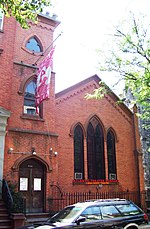Elgin Theater
1942 establishments in New York City1978 disestablishments in New York (state)Chelsea, ManhattanCinemas and movie theaters in ManhattanEighth Avenue (Manhattan) ... and 3 more
Moderne architecture in New York CityUse American English from June 2015Use mdy dates from June 2015

The Elgin Theater is a former movie theater on the corner of 19th Street and Eighth Avenue in the Chelsea neighborhood of Manhattan in New York City. The theater showed films from its opening in 1942 until 1978. Its longtime manager, Ben Barenholtz, invented midnight movie programming for the theater. Following a full renovation, the building reopened in 1982 as a 472-seat dance theater operated by the Joyce Theater.
Excerpt from the Wikipedia article Elgin Theater (License: CC BY-SA 3.0, Authors, Images).Elgin Theater
8th Avenue, New York Manhattan
Geographical coordinates (GPS) Address Phone number Website Nearby Places Show on map
Geographical coordinates (GPS)
| Latitude | Longitude |
|---|---|
| N 40.742766 ° | E -74.000545 ° |
Address
The Joyce Theater
8th Avenue 175
10011 New York, Manhattan
New York, United States
Open on Google Maps









